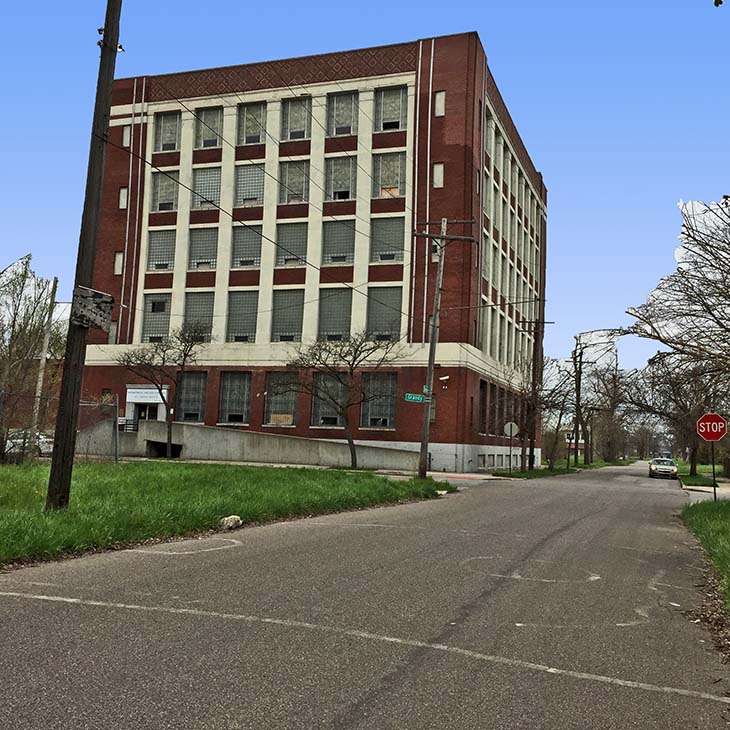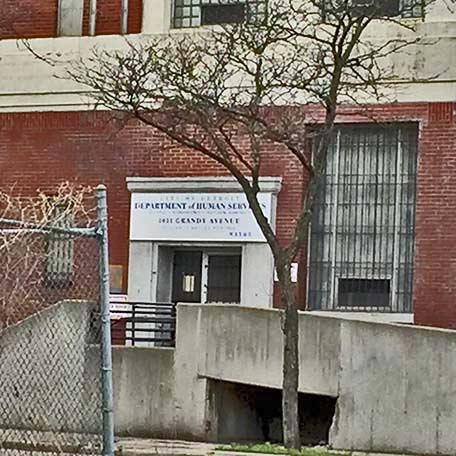

This building is not listed on any historic register. And, although it was designed by the city’s most gifted and prolific architect, Albert Kahn; it may not justify a listing because of its design. Detroit is recognized as one of the key cities in the development of the modern industrial union movement that helped to create and establish the American blue-collar middle class. Almost all discussion of the history of unions focuses upon men working for the railroads, in steel mills and in southeast Michigan’s numerous auto plants. But women played a role in the union movement, a role that is now forgotten. An historical marker on this building would help to remedy that omission.
Detroit became one of the nation’s leading tobacco centers in the 1880s. By 1885 there were at least 38 firms in Detroit turning out cigars and cut plug. The reason for this was that the fertile flat lands of southwestern Ontario were ideal for growing the long leaf tobacco that was used for tobacco products in that era. By the 1890s, Detroit’s cigar factories employed many women since the work, apparently, was deemed acceptable for women who were paid low salaries. Presumably, there was no other manufacturing industry in Detroit that employed many women. I believe that most of the women making cigars and cut plug were immigrants or daughters of immigrants. As early as the 1890s, women in some of the city’s cigar factories went on strike to demand higher wages and better working c onditions.
onditions.
James B. Duke invented a machine to mass-produce cigarettes in the early 1890s and the nation’s tobacco consumers gradually turned to cigarettes. But many men continued to enjoy their cigars and those thousands and thousands of men who worked in hot, dirty factories chewed tobacco every work day since this was assumed to keep the mouth moist. And while few women publically admitted it in an era when appropriate women did not use tobacco, many put a pinch of snuff in their mouth. So the demand for Detroit’s tobacco products was robust enough for investors to commission Albert Kahn, in the early 1920s, to build this massive factory. I know that this structure is often identified as the Mazer-Cressman Cigar Company structure but the original tobacco firm may have had a different name.
The Depression drastically reduced the sale of most consumer products. Numerous firms went into bankruptcy but others survived by manufacturing a cheaper version of their product to maintain their sales and stay in business. By the early 1930s, Studebaker had not produced cars at their massive Piquette Street plant for almost a decade but they revived that Detroit factory in the Depression and turned out a low-priced but fairly high quality car called The Rockne, named after the famous Notre Dame football coach. Alas, it did not sell well. The Mazer Cigar Company, in the Depression, put great effort into marketing a five cent cigar they called the Cadillac.
We are getting away from the story about how women drove the labor movement in Detroit.
By 1937, there were six cigar plants in the Detroit neighborhood bounded by Warren, Grandy, Milwaukee and St. Aubin. About three thousand women—almost all first and second generation Polish immigrants who lived nearby—rolled cigars every workday. Between 1929 and 1937, their wages had been cut 35 to 50 percent. These women frequently complained about their low wages, the speed with which they had to work, the absence of ventilation such that they breathed toxic tobacco dust all day long, the absence of adequate rest rooms and sexual harassment from their foremen.
On February 11, 1937, the sit-in strike that the United Auto Workers (UAW) had instituted against General Motors in Flint was settled peacefully. General Motors recognized that Governor Murphy was not going to use force to evict the sit-down strikers and that the sit-down strikers could, if they wished, destroy GM plants. Management so did what they were required to do by the Wagner Act and recognized the UAW. Five days later, the women at Webstein-Eisenlohr Cigar sat down and demanded a 10 percent pay increase. But they had a problem: they were not members of a union. They quickly located the head of Detroit’s Polish Trade Union Committee and, within a day a union was formed in accord with federal requirements. Within days, women employed at the other five cigar companies in the neighborhood: Mazer-Cressman, Essex, Bernard Schwartz, Tegge-Jackson and General Cigar sat down in their manufacturing plants and shut off the firms’ sales. Helen Nowak and Cecilia Chroniecki are credited with being the leading organizers of these sit-down strikes.
On March 4, Mazer-Cressman agreed to recognize the union and, the following day, Essex recognized the union as they were required by federal law. The other firms did not. In these sit-down strikes, managements consistently and forcefully argued that those siting down were trespassers and the city and state police were obligated to remove them. Mayors and governors were reluctant to dispatch such force since they knew there would be violence with numerous police officers and strikers injured. Furthermore, sit-down strikers cast many more votes than did factory owners.
On March 20, 1937, Detroit Mayor Frank Couzens, who was not viewed as a friend of labor, ordered a crack-down on the striking cigar workers. Police were dispatched to the Bernard Schwartz plant to arrest the trespassers. The women resisted and so Detroit police officers dragged them out of the factory using considerable force. Needless to say, this was not very popular with the increasingly strong labor movement in Detroit. UAW president Homer Martin called for a rally to protest Mayor Couzens’ use of force to evict sit down strikers from their employers’ factories. According to some reports, 200,000 showed up in Cadillac Square on March 24 to protest. In addition to the cigar maker, there were numerous other sit-down strikes underway at auto parts plants in Detroit.
Governor Frank Murphy was seen as quite supportive of the sit-down strikers in Michigan. A contingent of the women who were still sitting in at the other four cigar plants arranged a meeting with Governor Murphy on April 1, 1937. He promised to consider their issues and, I infer, used his powers to persuade both Detroit’s Mayor Couzens to stop using violence to remove the trespassing sit-down strikers and to insist that cigar manufacturers comply with federal law. Governor Murphy called that the owners of the cigar firms and the striking women meet with him at his office on April 22. The manufacturers agreed to recognize Cigar Workers Union Local 24. Thus the striking Polish women won this round of confrontation with Detroit’s largest cigar producers.
I do not know when the manufacturing of cigars and cut plug came to an end in Detroit. I believe that tobacco continued to be a profitable crop in southwest Ontario until the end of the 1960s but it is no longer grown them. Certainly, the demand for cigars and cut plug has greatly decreased in recent decades and, to the best of my knowledge, no commercial cigars have been rolled in Detroit for forty or fifty years.
The cigar firms located in the area described in the first paragraph included the following:
Essex Cigar Company – 5247 Grandy at East Frederick. This building has been demolished.
General Cigar – address unknown – about 70 workers at the time of the sit-down strike
Mazer-Cressman – Their building is described on this page. About 400 workers were employed at the time of the sit-down strike.
Bernard Schwartz Cigar – 2180 East Milwaukee at DuBois. This structure was designed by Albert Kahn in 1925, his third cigar plant. Mazer-Cressman and San Telmo were the other two. I believe it was the last major cigar factory constructed in the city. It was razed in 1981 in conjunction with the construction of the General Motors Hamtramck Assembly plant. About 400 workers were employed at time of the sit-down strike
Tegge-Jackson Cigar – address unknown
Websten-Eisenlohr Cigar – address unknown.
The building I know as Banner Cigar at 2941 East Warren housed one of the cigar firms listed but Ido not know which one.
In 2016, there were at least six major tobacco building standing in Detroit. There may be more. The ones I know about are, in order of birthdate:
Brown Brothers Cigar - 119 State Street in Capitol Park. Designed by Gordon W. LLoyd and opened in 1887. In 2015,the building was purchased by the Lear Corporation and will become a center for design.
Globe Tobacco - 407 East Fort Street. Designed and built by Alexander Chapton and opened in 1888. This building was renovated for use as offices and then purchased by Dan Gilbert's Bedrock financial and real estate firm.
San Telmo Cigar - 5716 Michigan Avenue in southwest Detroit. Designed by Albert Kahn and opened in 1910. This structure now is the home of the Southwest Solutions organization.
John P. Hemmerter Building - 230-242 East Grand River near Capitol Park. Designed by Richard Raseman. This building was also purchased in 2015 by the Lear Corporation.
Banner Cigar - 2941 West Warren. Designed by Louis Kamper and opened in 1914. Plans were announced in 2015 ro convert this structure into a gallary for art and artists.
Mazer Cigar - 5031 Grandy. Designed by Albert Kahn and opened in 1924. In 2016, this structure provided office space for the city of Detroit.
Architect: Albert Kahn
Date of Construction: 1924
Use in 2016: Department of Human Services, City of Detroit
City of Detroit Designated Historic District: Not listed
State of Michigan Registry of Historic Sites: Not listed
National Register of Historic Places: Not listed
photograph: Ren Farley, April 30, 2016
Description updated: November, 2016
Return to Industrial Sites
Return to Homepage